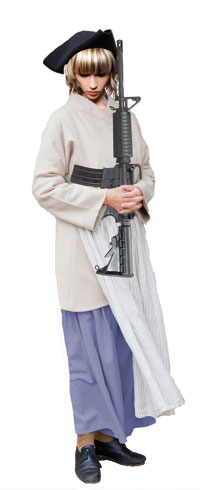May 2014 | view this story as a .pdf
By Colin S. Sargent
Just how many arms did Revolutionary-era Mainers bear?
 The history most Mainers learn back in our hazy school days about the Revolutionary War suggests guns were to be found everywhere and were available to equip almost everyone.
The history most Mainers learn back in our hazy school days about the Revolutionary War suggests guns were to be found everywhere and were available to equip almost everyone.
Maine.gov claims “most men, like Daniel Sullivan, joined a local militia unit to serve for a three- or nine-month stint, subject to a call-up in response to a nearby emergency; others joined what was known as the Regular Continental Army for three years or for the duration of hostilities.” But were there firelocks enough swimming around to justify the image of every man in Maine tugging on his tricorner and shouldering his musket?
In 1770, there were about 31,300 people living in the part of Massachusetts called Maine today, according to the U.S. Bureau of the Census. As Stephen A. Schmidt, consultant to James D. Julia, a market leader in firearms auctions, says, there were barely enough firearms in the whole of the Thirteen Colonies to arm every Mainer; “Fifty thousand guns in colonial America is a pretty easy number. If you’re going to say a hundred thousand, that’s probably reaching pretty far.” How many of those could have been in Maine? Since there were two million people in the colonies at the time, that’s only about one gun for every twenty people when legend has it we had a gun in every farmhouse. What’s it today? A little over four in ten in Maine, reports the CDC from a nationwide survey. John Adams bemoaned the universal shortage of arms in 1777: “They [the militia] are distressed for want of arms. Many have none, we shall rake and scrape enough…by favor of Heaven.” The guns just weren’t there. Though Maine locals defended Machias successfully against a tiny force in 1779, they were of little use in the much more important Penobscot expedition to try to retake Castine from the British. In any case, Maine’s population today is far better armed and far better equipped than we were at the dawn of the Revolutionary War.
Firearms, even smoothbore muskets, were expensive outlays until the Industrial Revolution half a century later brought mass production and replaceable parts to truly arm the masses. American gun production, even for the military, didn’t even get off the ground until the 150,000 production run of the 1795 Springfield musket–shooting to pieces the urban myth that our Founding Fathers were born with guns in their hands–and most of those were converted to rifled muskets for use in the American Civil War. Gunpowder and firearms were also highly expensive, so much so that the Continental Army had chronic powder shortages throughout the entire war.
Why, then, does this image of mass participation and firearms ownership in the time of the Revolution exist? The answer lies in the political battles in the wake of the Revolution and our self-delusion that American determination was mostly responsible for the success of the revolution, when the American colonies were trying to knit themselves into a country. A standing army was thought to be a liability by those who wanted a weak, inexpensive central government, so rosy pictures were painted of a militia effectiveness that never was. Further, even the American military suffered greatly until French financing and training created a far more professional force. But what was the extent of that military aid? The firearms that survive this period speak volumes, often in a French accent. “Over the course of the Revolution, we were given between 100,000 and 200,000 guns from France. French military aid more than doubled, maybe even quadrupled, the number of guns in the country.” Most of these were Charleville muskets in .69 caliber. After soldiers took these most practical souvenirs home with them following the war, we finally had the kind of widespread rural armaments we project further back today. Talk about arming the natives; seen in this light, the entire adventure of our Revolution appears to be, more than anything else, a means by which the French pulled the British lion’s tail.
Lionizing the militia painted over the unpleasantness of our fledgling country needing both foreign military aid and the formalized violence of its government. Our full-time soldiers and our friends in France secured our freedom, not our part-time volunteers despite the enduring myth of the minuteman. Today, however, with over 400,000 weapons already in the state and industrialized manufacturing at Saco Operations and Windham Weaponry, we’re far better prepared than our Founding Fathers for another British invasion.





0 Comments